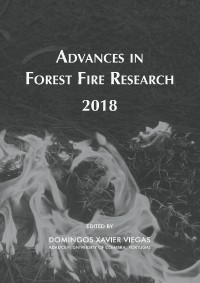Please use this identifier to cite or link to this item:
https://hdl.handle.net/10316.2/44526| Title: | Modelling of the rate of fire spread in heterogeneous fuel beds based on experimental data | Authors: | Almeida, Miguel Viegas, Domingos Xavier Mendonça, Filipe Fois, Cinzia Lopes, Abel |
Keywords: | combustibility;fuel mixtures;heterogeneous fuels;moisture content;rate of spread | Issue Date: | 2018 | Publisher: | Imprensa da Universidade de Coimbra | Journal: | http://hdl.handle.net/10316.2/44517 | Abstract: | 195 laboratory tests were performed to analyse the effect of either slope and wind in the fire spreading in mixed fuel beds composed by one live fuel and one dead fuel – live Pinus pinaster needles and straw were the fuels used, respectively. Several models were built by other researchers to predict the fire spread in mixture fuel beds. Many of these models were produced using data achieved for conditions of no wind nor slope. In these tests, the effect of the airflow/wind and the effect of slope in the fire spread in mixed fuel beds was analysed. It was found that the presence of wind or slope do not clearly affect the value of the critical mass fraction xc that correspond to the minimum percentage of the dead fuel required to sustain the fire propagation. The experimental results were modelled using exponential decay law applied to mixed fuel beds and the concept of degree of curing. These models show a good fit to the experimental results hereby presented so they can be extended to conditions of wind and slope. In the modelling of surface forest fire spread, the prediction of the rate of spread (ROS) of a fire front, or of part of it, is the main goal that is attempted in order to be able to estimate the advance of the fire front in the course of time. It is commonly accepted that the ROS at a given section of the fire perimeter depends on the fuel bed properties, local topography and atmospheric conditions, namely air flow intensity and direction (e.g. Linn et al., 2007; Cavard et al., 2015). Although this concept can be challenged in several situations when the dynamic behaviour of the fire changes its environment and modifies its ROS properties (Hilton et al., 2016). In this work, we shall assume, as it is commonly done, that fire spreads in a quasi-steady state and that average values of the ROS can be established and determined at least during short periods of time. This work is a follow up of previous works on ROS in heterogeneous fuel beds (Viegas et al., 2010 and 2013) performed by some of the authors of the present publication. | URI: | https://hdl.handle.net/10316.2/44526 | ISBN: | 978-989-26-16-506 (PDF) | DOI: | 10.14195/978-989-26-16-506_9 | Rights: | open access |
| Appears in Collections: | Advances in forest fire research 2018 |
Files in This Item:
| File | Description | Size | Format | |
|---|---|---|---|---|
| modelling_of_the_rate_of_fire_spread.pdf | 1.35 MB | Adobe PDF |  |
Items in DSpace are protected by copyright, with all rights reserved, unless otherwise indicated.
